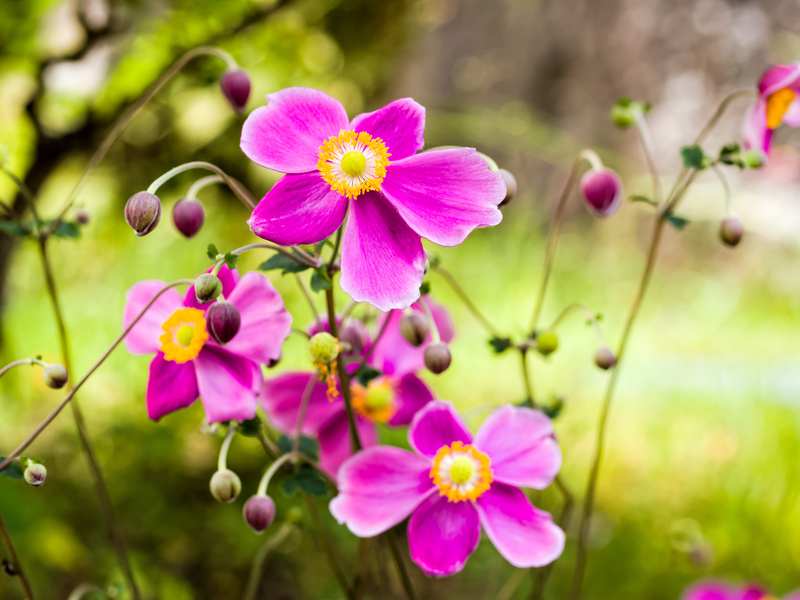Unveiling the Potential of an Untamed Garden
Posted on 24/06/2025
Unveiling the Potential of an Untamed Garden
Are you looking to unlock the secrets of your wild, overgrown backyard? If you've gazed at a neglected patch of green and wondered what possibilities lie beneath the brambles and weeds, you're not alone. Many homeowners and garden enthusiasts overlook the hidden treasures of an untamed garden, yet these wild spaces offer unique opportunities for creativity, biodiversity, and personal fulfillment. In this comprehensive guide, we'll delve deep into unveiling the potential of an untamed garden, helping you transform chaos into a thriving, enchanting sanctuary.
What is an Untamed Garden?
An untamed garden, sometimes referred to as a wild or neglected garden, is a green space that has been left to grow naturally with minimal human intervention. While these spaces might seem chaotic at first glance, they often harbor a wealth of native plants, beneficial insects, and untapped beauty. Rather than seeing an untamed garden as an eyesore, it's time to reframe it as a canvas, ready to be shaped and cherished.
Why Untamed Gardens Matter
- Biodiversity: Wild gardens act as havens for wildlife, supporting pollinators, birds, small mammals, and native plants.
- Low Maintenance: With natural growth cycles, these gardens often require less watering, fertilizing, and upkeep than traditional lawns or manicured beds.
- Eco-Friendly: Untamed gardens utilize fewer resources and chemical inputs, aligning with sustainable gardening practices.
- Personal Expression: They offer a chance to create a unique, personalized landscape that reflects your preferences and values.

Discovering the Hidden Value of an Overgrown Garden
When considering the potential of an overgrown garden, many people only see hard work ahead. However, every wild patch holds extraordinary possibilities. From introducing exotic blooms to fostering native flora, an untamed yard can become a vibrant, productive environment.
Assessing Your Unmanaged Green Space
- Inventory Existing Features: Identify not only weeds and unwanted growth, but also desirable trees, shrubs, perennials, and hardscaping elements.
- Observe Sun and Shade Patterns: Monitor how sunlight moves across your garden throughout the day. Wild areas may shield shade-loving plants or offer sunny spots perfect for vegetable beds.
- Soil Quality: Wild gardens often benefit from undisturbed soil teeming with beneficial microbes and rich organic matter left by decaying plants.
- Wildlife Activity: Watch for birds, bees, butterflies, and beneficial insects, all indicators of a healthy ecosystem.
Embracing the Wild: Turning Weeds into Wonders
One of the greatest challenges--and opportunities--when working with an untamed garden is managing what many call "weeds." However, some of these so-called weeds are actually valuable wildflowers (like dandelions and violets), while others improve the soil or attract pollinators.
Edible and Medicinal Wild Plants
- Dandelion: Not only a nectar source for bees, but also edible roots, leaves, and flowers for humans.
- Nettles: High in nutrients; use young shoots in soups and teas--after proper handling!
- Purslane: Rich in omega-3 fatty acids, a wild green for salads or sauteing.
How to Tame Your Garden Without Losing Its Wild Charm
Some gardeners fear that "cleaning up" untamed gardens means eliminating the natural beauty that sets them apart. The key is balancing structure and wilderness. Here's how:
1. Create Defined Pathways
A simple wood-chip or stone path carves out order within chaos, guiding visitors through your garden while leaving wild patches undisturbed.
2. Designate Wild Zones
Let certain areas remain largely untouched. These zones support wildlife, act as pollinator habitats, and serve as a reminder of the garden's original essence.
3. Selective Pruning and Planting
Thin invasive species, prune woody vegetation where necessary, and introduce native perennials and shrubs for color and diversity.
4. Upcycle and Reuse
Use deadwood as rustic edging for beds, leaf mulch to build fertile soil, or old garden tools as quirky art. This approach respects the garden's history while nurturing future growth.
The Benefits of Revealing an Undiscovered Backyard Garden
- Enhanced Biodiversity: Native and naturalized plants attract a wider range of beneficial creatures, balancing pests and pollinators.
- Educational Value: Children and adults alike can learn from the cycles of growth, decay, and renewal present in a wild garden.
- Stress Reduction: Studies show spending time in natural spaces can lower stress and boost well-being.
- Unique Beauty: Wild gardens offer seasonal surprises--unexpected blooms, rare butterflies, or unusual fungi.
Step-by-Step: Unlocking the Potential of Untamed Garden Spaces
-
Survey Your Landscape:
- Walk your garden with a notebook and camera; record notable plants, wildlife, and hardscape features.
- Mark areas of heavy shade, running water after rain, and especially overgrown or impassable sections.
-
Set Goals:
- Do you want a pollinator paradise, a children's play zone, a vegetable patch, or a peaceful retreat?
- Prioritize goals to give focus to your gradual transformation.
-
Plan for Phased Development:
- Divide the garden into manageable zones to tackle over several seasons.
- Start with the most congested or least appealing area as your first project.
-
Remove Only the Worst Offenders:
- Eliminate invasive species and hazardous debris first. Leave benign wildflowers and established shrubs for assessment.
- Compost removed plant matter to return nutrients to the soil.
-
Introduce Native Plants:
- Add species adapted to your local climate for low maintenance and greater ecological value.
- Mulch and water new plantings as needed, but allow existing wild flora to flourish alongside new additions.
-
Install Features for Enjoyment and Access:
- Create a seating area, a small pond, or stepping-stone paths.
- Highlight found objects or natural art to showcase your garden transformation.
Expert Tips for Uncovering Your Garden's Hidden Wonders
- Identify Before You Remove: Use field guides to distinguish between valuable native plants and true weeds.
- Observe Over Time: Let your garden reveal itself across seasons--some plants and wildlife emerge only at certain times of year.
- Encourage Natural Balance: Support beneficial insects with insect hotels and flowering plants. Avoid pesticides that disrupt natural cycles.
- Invite Community Input: Local gardening clubs and online forums can help identify plants and suggest sustainable management practices.
The Future of Untamed Gardens: Beyond Traditional Landscaping
Modern gardeners and landscape designers are increasingly embracing the wild. Whether you're passionate about rewilding, supporting pollinator corridors, or simply crave a lawn alternative, your untamed garden can be part of a broader, environmentally beneficial movement. Restoring native habitats, locking away carbon in perennial plants, and creating a haven for urban wildlife are all outcomes possible from your backyard.
Transforming Perceptions
Rather than battling nature, forward-thinking gardeners collaborate with it. The result is not only less labor, but richer rewards. With every wildflower that blooms, every bird that nests, you witness the unfolding tapestry of life that was always present, just hidden beneath the surface.

FAQs: Unveiling the Potential of a Wild Garden
- Can an untamed garden increase property value?
Yes! With thoughtful planning, a wild garden can become a major feature, appealing to buyers seeking sustainability and beauty. - Is managing a wild garden labor-intensive?
While initial cleanup can be involved, maintenance levels often drop over time compared to manicured lawns or borders. - What about pests?
Biodiversity in untamed gardens fosters natural predators and balances populations, resulting in fewer pest problems overall.
Conclusion: Embrace the Beauty and Possibility of Untamed Gardens
Unveiling the potential of an untamed garden is a journey that rewards curiosity, patience, and imagination. Beneath overgrowth and disorder lies the chance to support local ecology, express creativity, and discover peace in nature's embrace. By taking thoughtful steps to balance wildness with intentional design, you will transform your neglected backyard into a space bursting with life, beauty, and possibility.
Ready to begin? Step outside--your wild garden awaits!

